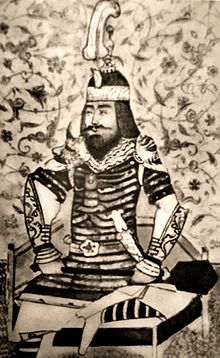Timurleng
| Temür | |
|---|---|
| amir | |

A Timurid-era illustration of Timur
|
|
| Reign | 9 April 1370– 14 February 1405 |
| Coronation | 9 April 1370, Balkh |
| Predecessor | Amir Hussain |
| Successor | Khalil Sultan |
| Born | 9 April 1336 Kesh, Chagatai Khanate (now in Uzbekistan) |
| Died | 19 February 1405 (aged 68) Otrar, Farab, near Shymkent, Syr Darya (now in Kazakhstan) |
| Burial | Gur-e-Amir, Samarkand |
| Spouse |
|
| Issue Detail |
|
| House | Barlas Timurid |
| Father | Amir Taraghai |
| Mother | Tekina Khatun |
| Religion | Islam |
Timur (Persian: تیمور Temūr, Chagatai: Temür; 9 April 1336 – 18 February 1405), historically known as Amir Timur and Tamerlane (Persian: تيمور لنگ Temūr(-i) Lang, "Timur the Lame"), was a Turco-Mongol conqueror. As the founder of the Timurid Empire in Persia and Central Asia he became the first ruler in the Timurid dynasty. According to John Joseph Saunders, Timur's background was Iranized and not steppe nomadic.
Born into the Barlas confederation in Transoxiana (in modern-day Uzbekistan) on 9 April 1336, Timur gained control of the western Chagatai Khanate by 1370. From that base he led military campaigns across Western, South and Central Asia, the Caucasus and southern Russia, and emerged as the most powerful ruler in the Muslim world after defeating the Mamluks of Egypt and Syria, the emerging Ottoman Empire, and the declining Delhi Sultanate. From these conquests he founded the Timurid Empire, but this empire fragmented shortly after his death.
Timur was the last of the great nomadic conquerors of the Eurasian Steppe, and his empire set the stage for the rise of the more structured and lasting Gunpowder Empires in the 1500s and 1600s. Timur envisioned the restoration of the Mongol Empire of Genghis Khan (died 1227). According to Beatrice Forbes Manz, "in his formal correspondence Temur continued throughout his life to portray himself as the restorer of Chinggisid rights. He justified his Iranian, Mamluk, and Ottoman campaigns as a re-imposition of legitimate Mongol control over lands taken by usurpers." To legitimize his conquests, Timur relied on Islamic symbols and language, referred to himself as the "Sword of Islam", and patronized educational and religious institutions. He converted nearly all the Borjigin leaders to Islam during his lifetime. "Temur, a non-Chinggisid, tried to build a double legitimacy based on his role as both guardian and restorer of the Mongol Empire." Timur also decisively defeated the Christian Knights Hospitaller at the Siege of Smyrna, styling himself a ghazi. By the end of his reign, Timur had gained complete control over all the remnants of the Chagatai Khanate, the Ilkhanate, and the Golden Horde, and even attempted to restore the Yuan dynasty in China.
...
Wikipedia
